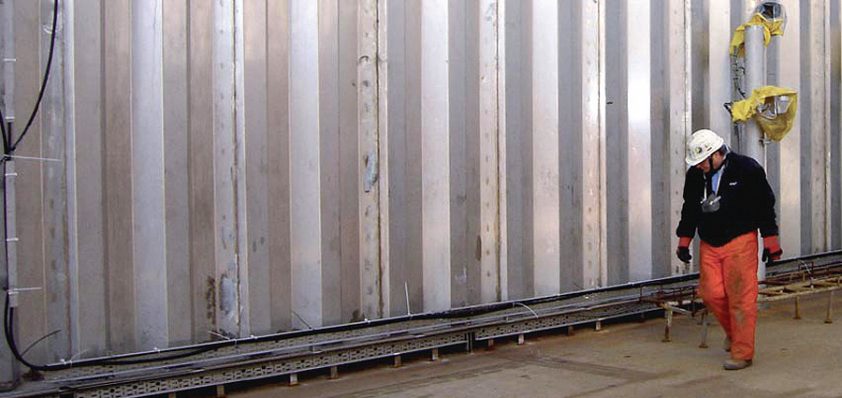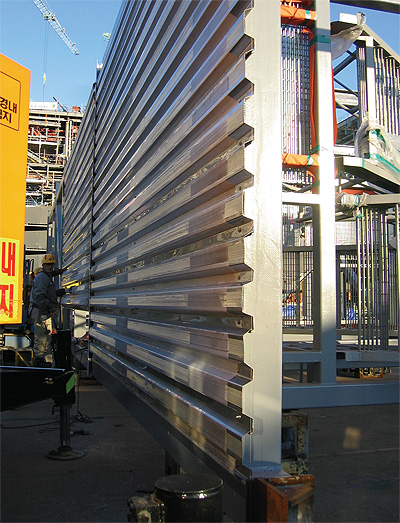
ZNS Van Dam
Safety first
ZNS Van Dam specialises in the design and production of fire and blast protective products and solutions to protect personnel and critical safety equipment.
The company, whose main clients come from the oil and gas as well as the infrastructure and defence markets, is committed to developing a product portfolio that prevents the escalation of events following hydrocarbon explosions, fire and any impact damage that subsequently follows.
It is a company with a proud history that stretches back over more than a century. Van Dam started as a sheet metal company in 1906, supplying the local shipbuilding industry with air breathers  and various engineered sheet metal specialities. This remained the core business for the next 50 years before the company took tentative steps into the building industry. The progression into the oil and gas industry at the start of the 1970s was a natural step given Van Dam’s expertise with metal cladding and specialist safety doors.
and various engineered sheet metal specialities. This remained the core business for the next 50 years before the company took tentative steps into the building industry. The progression into the oil and gas industry at the start of the 1970s was a natural step given Van Dam’s expertise with metal cladding and specialist safety doors.
The following decade saw the company boost its client portfolio and reputation by moving into the infrastructure and naval market. Using the experience gained from its work in the everexpanding oil and gas industry, Van Dam proved its expertise further by designing and building doors to order, hatch specialities and walls. Its financial future was virtually secured in 2002 when it was taken over by S3C Holding, a global operating group of Dutch companies. Following a strategic evaluation of the organisation earlier in the year, it was decided that Van Dam would concentrate solely on its core businesses and customers in the oil and gas and infrastructure and defence industries.
Outlining the benefits of being part of a business conglomerate, Leo VanderHoest, the company’s managing director, says: “Because we are part of a strong financial holding, we are able to carry out some of the biggest projects imaginable. As an example of what we are capable of, we recently carried out a project for Shell on the Sakhalin Isles where we installed 50,000 sq m of blast and fire proof walls on one rig and 60,000 on another. The strength of our mother company allows us to take on such assignments.”
However the overriding reason that companies the calibre of Shell award contracts is because they believe in the quality of products that they will be benefiting from. The main staples of the product offering for the oil and gas industry consists of blast and fire resistant walls and cladding as well as blast and/or fire doors, water and gas tight doors, which are also able to withstand explosions and the subsequent fires. Van Dam is also able to install total solutions, encompassing walls, doors, windows, interfacing work, full engineering and design. Furthermore, all products are tested and certified at the company’s centres in the UK and the Netherlands.
It is the range of the products, as well as the quality, that Leo believes is one the company’s main strengths. “The scale of the range we offer is one of Van Dam’s unique selling points, we develop products for every eventuality. Our focus is to guarantee the safety of people and machinery. Let’s say there is an explosion on an oil-rig – then our products, whether they are the walls, doors or windows – will protect both the employees and the expensive equipment from both the impact and the following fire,” he says.
That guarantee has seen Van Dam work with most of the major players within the oil and gas industry, including Total, Amoco, Aker, Maersk and of course, Shell. It has also carried out work for a number of high-profile names in the naval and infrastructure sector, with the British, Dutch and Norwegian Navies all counted as clients for whom the company installed blast-proof membrane doors. Commenting on the relationships with customers, Leo says: “Everything that we design and engineer is tailored to the specific needs of the client. We are constantly developing through listening to the market about their needs.”
An illustration of such is the new generationthree fire and blast wall that offers customers the same level of protection at a lower cost. The wall, which is 60 per cent lighter than some of its predecessors, is also easier to assemble as it is installed using bolts rather than having to be welded together. “It has so many advantages against similar walls that our competitors offer,” says Leo. “Against the more traditional walls it has cost savings of 30 per cent and weight savings of 60 per cent. It is a massively advantageous piece of equipment that we are selling a high quantity of.”
Such technological breakthroughs should hold Van Dam in good stead in an industry that Leo feels is going from strength to strength. “There are so many opportunities that we are now able to focus on several parts of the world. Looking forward we will be looking to expand our market share all over Europe, particularly in the North Sea, in South America, the United States and also in the Far and Middle East,” he comments.
In conclusion, Leo says: “We are constantly developing new products because without safety equipment people would be seriously injured and killed. If a fire can be suppressed for two hours then personnel can escape via the helicopter-deck. This is very important, and in our line of business every minute counts!”
ZNS Van Dam
Products Fire and blast protection